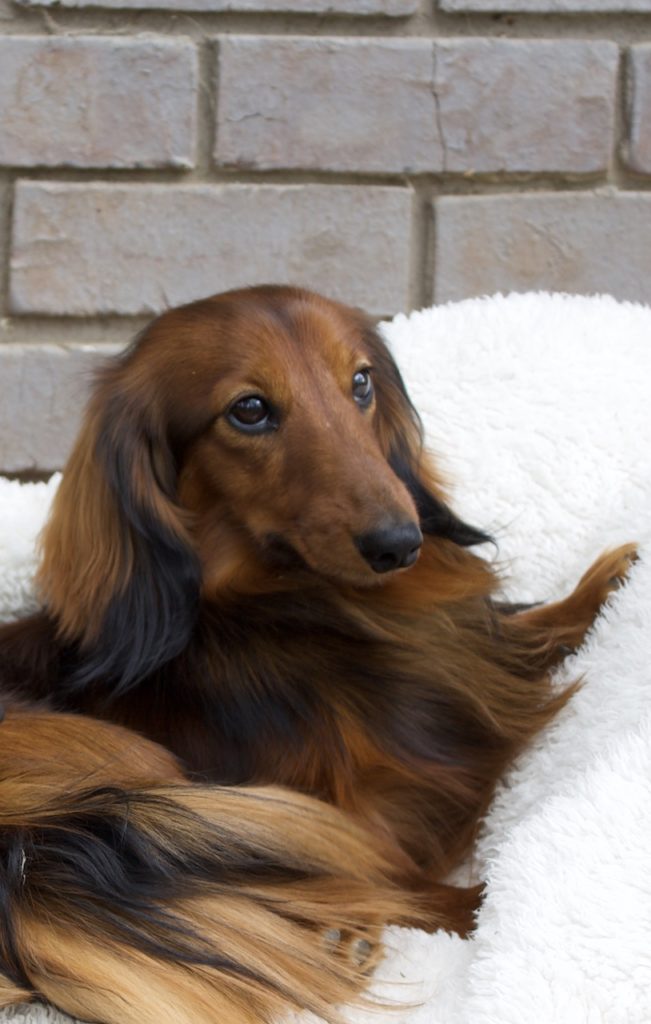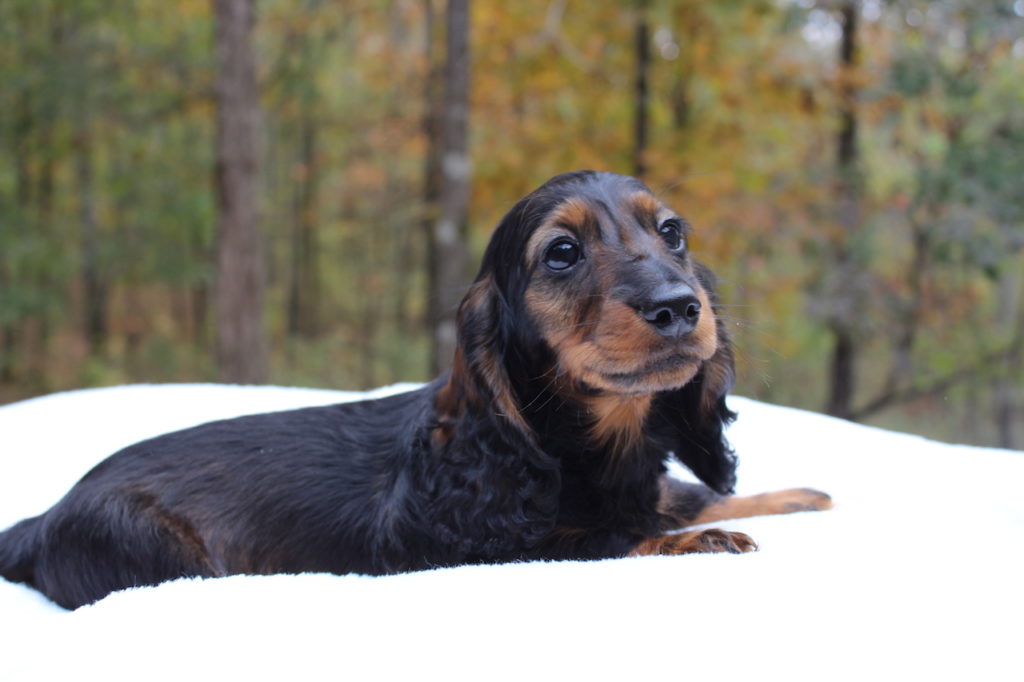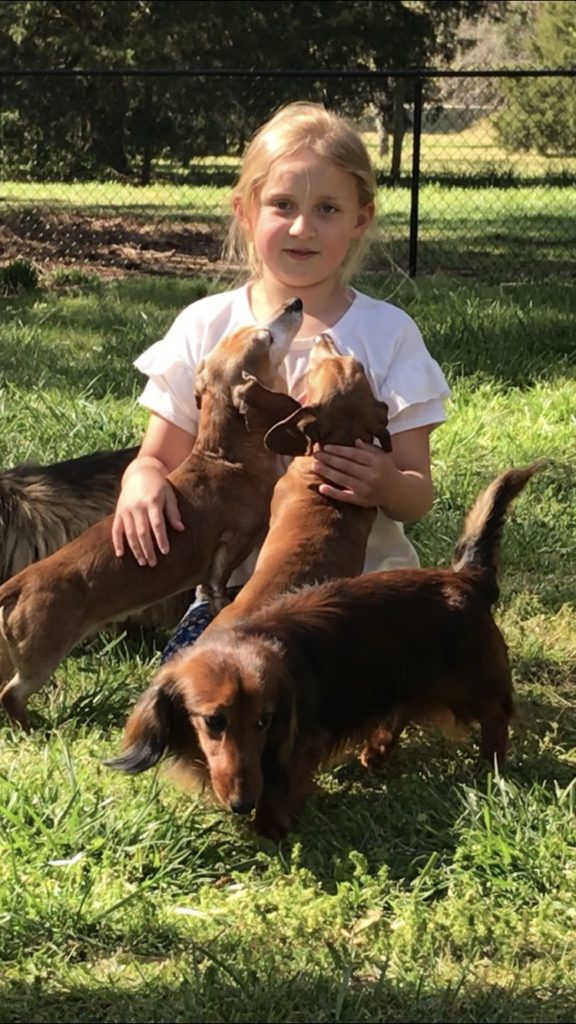Dachshund History

The Dachshund is a breed that dates back 600 years. Historical artwork depicts small, long bodied dogs hunting badgers in Germany during the 15th century. At this time, the dogs were used for hunting, and were prized for their hound-tracking ability, their size, and their temperament that closely matched terriers. All of these characteristics made it possible for the Dachshund to effectively track badgers and other small creatures that dwelled in holes.
The German name Dachshund actually means “badger dog” (Dachs – Badger & Hund – Dog), and was applied to the breed in the early 17 th century.
Originally, Dachshunds were bred with two types of coats: long hair and short hair. The third coat variety of Dachshund – wire hair – wasn’t introduced until the late 1800’s. As Dachshunds were being developed, two sizes were being bred in order to accommodate the hunters needs, based on what type of game was to be hunted. The larger sized Dachshund weighed between 30 and 35 pounds and was used to hunt larger animals such as wild boars and badgers. The smaller types weighed between 16 and 22 pounds, and were used to hunt hares and foxes. Today there are still two different sizes of Dachshund – Standard and Miniature.
As time passed, Dachshunds were used less for hunting purposes and more as family pets. The Dachshund was introduced to America in the 19th century, and the standard smooth haired variety continues to be one of the more popular beloved dog breeds today.
Is a Dachshund right for me?

Dachshunds are one of the most popular breeds around. With an extensive repertoire of distinguishing characteristics, it’s not hard to understand why. But like any breed, a Dachshund isn’t for everyone.
- Dachshunds are very intelligent and quick to learn, but they are also very independent and don’t appreciate being bossed around. If you train your dog using rewards, rather than force, you’re more likely to get a Dachshund who will mind you rather than battle you. Dachshunds have achieved high honors in obedience, but they are not like retrievers and herding dogs that were bred to work following human direction.
- Dachshunds are small but energetic. They have to exercise their bodies and minds every day. They love nap time and take many throughout the day, but in between naps, they are very energetic! Fortunately, it doesn’t take much to burn off their excess energy…a walk around the neighborhood or games in the backyard. Plus they get a fair amount of exercise just running back and forth inside.
- Dachshunds are not jogging companions. It is true that Dachshunds can run farther than you would think, but those short legs have limits. So if you really want a jogging partner, choose something with longer legs.
Coat Types
The Dachshund is well known for his lively, charming, sometimes willful personality. The Smooth Coat, Wirehaired Coat, and Longhaired Dachshund share common traits, they differ in some ways, too. Here’s a closer look at the temperaments of all three.
The Independent Smooth Coat
The smooth haired Dachshund often becomes attached to one member of the family. Independent yet friendly, they are lovable and energetic dogs that make excellent family pets. The smooth coat on the Dachshund is the easiest of the three coats to care for.
The Gentle Longhaired
They tend to be calmer, with a less terrier-like temperament. While the Longhaired Dachshund is playful, he needs less exercise than both the Smooth Coat and Wirehaired Dachshund. Because of their long wavy locks, this Dachshund needs to be groomed a few times a week to prevent matting. A good brushing in areas where the hair is thick will do. Then simply comb the areas where the hair is a bit thinner.
The Spunky Wirehaired
The Wirehaired Dachshund is the real extrovert, reveling in games and possessing a clownish sense of humor. With a rough outer coat and a soft, short undercoat, the Wirehaired Doxie needs regular grooming to keep his coat in top condition. Every spring and fall, this Dachshund’s coat needs to be “stripped.” This simply means you need to pluck out individual hairs in his top coat. While it may sound painful, these loose hairs come out easily when the time is right when you use the proper utensils. You can clip his coat as well.
Socializing Your Dachshund Puppy

Socializing your puppy is key to ensuring you’ll have a happy, confident and well-adjusted dog for life. From 7 weeks to 4 months of age, your puppy goes through a socialization period that permanently shapes his future personality and how he will react to things in his environment as an adult. Gently exposing him to a wide variety of people, places and situations now makes a huge, permanent difference! Also, it is important to note that when you buy a puppy from a responsible breeder, the process can start even earlier. Gentle handling by the breeder in the first several weeks of your puppy’s life is helpful in the development of a friendly, confident dog. As early as 3 week of age, puppies may begin to approach a person who is passively observing them, and having a knowledgeable breeder to encourage a positive experience with people is beneficial to the puppy’s adult behavior. The idea behind socialization is helping your puppy become acclimated to all types of sights, sounds, and smells in a positive manner. Proper socialization can prevent a dog from being always fearful of children, for example, or of riding in a car, and it will help him develop into a well-mannered, happy companion. Having a dog who is well-adjusted and confident can even go as far as to save his life one day. According to the American Veterinary Society of Animal Behavior, improper socialization can lead to behavior problems later in life. Also, the organization’s position statement on this reads: “Behavioral issues, not infectious diseases, are the number one cause of death for dogs under three years of age.” If your dog becomes lost or if something happens to you, the fact that he is easily able to accept new places and people can better ensure he will be cared for until you are located or rehomed if necessary. As mentioned earlier, your breeder will start the socialization process as early as the puppy’s first few days of life by gently handling him and allowing him to explore his curiosity. But when the puppy comes home with you, the crucial socialization period begins, so it is important to continue this process. Here are some basic steps to follow: Introduce him to new sights, sounds and smells: To a puppy, the whole world is new, strange, and unusual, so think of everything he encounters as an opportunity to make a new positive association. Try to come up with as many different types of people, places, noises, and textures as you can and help your puppy be exposed to them. That means, for instance, have him walk on carpet, hardwood, tile, and linoleum floors; have him meet an old person, a young person, a person wearing sunglasses, etc. Make it positive: Most importantly, when introducing all of these new experiences to your puppy, make sure he is getting treats and praise so that he associates what he is being exposed to and the feeling of seeing something new as a fun thing. Also, don’t be stressed yourself! Dogs can read our emotions. So if you are nervous while introducing your puppy to a larger dog, for example, your puppy will be nervous, too, and may become fearful of larger dogs in the future. Involve the family: By having different people taking part in the socialization process, you are continuously taking the puppy out of his comfort zone, letting him know that he might experience something new no matter who he is with. Make it a fun game for the kids by having them write down a list of everything new the puppy experienced that day while with them, such as “someone in a baseball cap” or “a police siren.” Take baby steps: Try to avoid doing too much too fast. For instance, if you want your puppy to get accustomed to being handled by multiple people he doesn’t know, start with a few family members and slowly integrate one stranger, then two, and so on. Starting this process by taking your puppy to a huge party or a very busy public place can be overwhelming and result in a fearful response to groups of strangers in the future. Take it public: Once your puppy is used to the small amounts of stimuli, move outside of his comfort zone to expand the amount of new experiences he will have. Take him to the pet store (after he has started his vaccination series) or over to a friend’s house for a puppy play date.